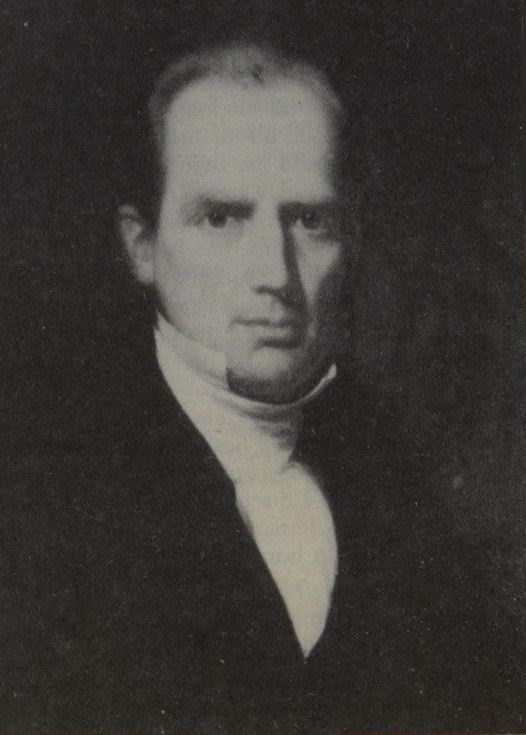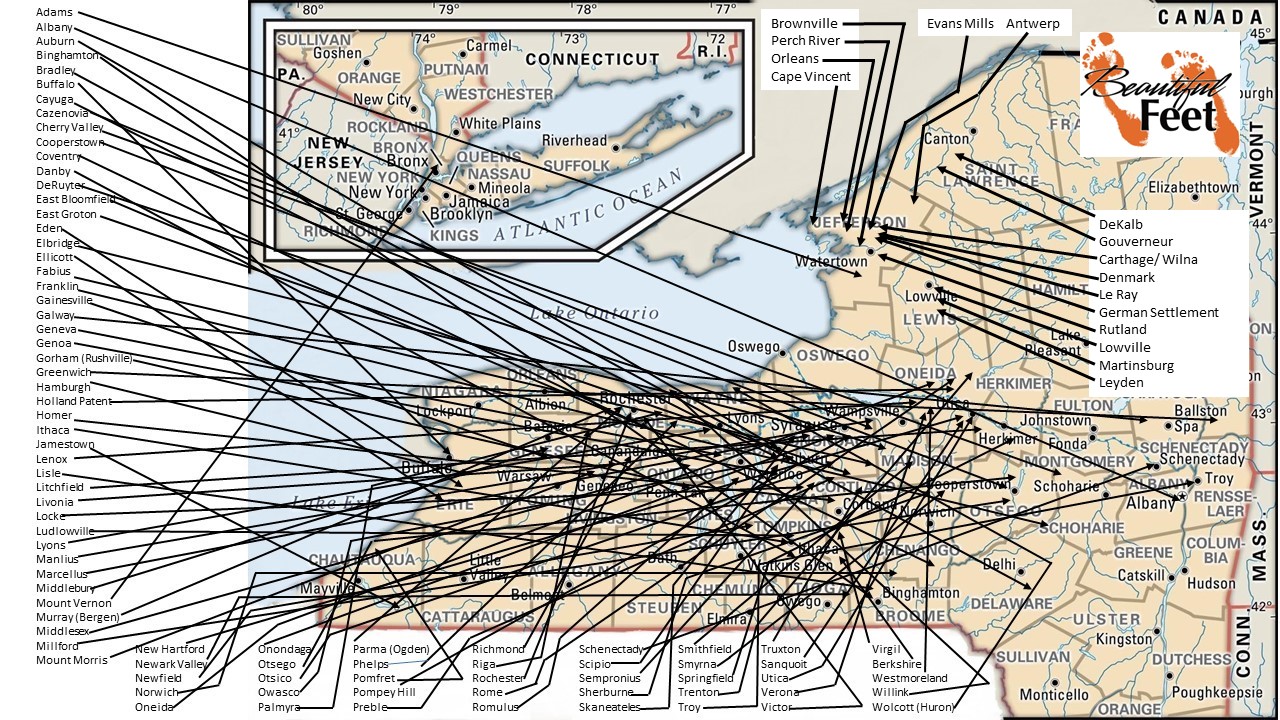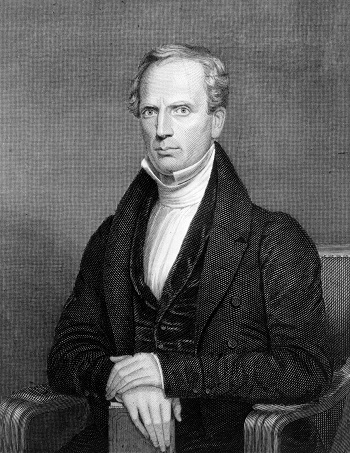1825 Revival in De Kalb, New York (2 revivals)


The state of New York is outlined in red
Preliminary Reading
To help with the historical context, we recommend reading about the revivals that had been previously occurring in other New England states. Those revivals can be read with these accounts:
► 1790-1840 Second Great Awakening
► 150 New England Revivals (1797 – 1814)
► 1815-1840 Upstate New York Revivals
Introduction
Charles G. Finney (1792-1875) was raised in Oneida County, New York, which at that time was still considered a wilderness. There were no Sunday Schools or opportunities for religious education, leaving the people with no religious convictions. The few ministers that passed through were described as uneducated, and laughably so.
Finney’s conversion in 1821, at 29 years of age, was extremely dramatic, and was accompanied by a powerful baptism of the Holy Spirit. You can read about it here. Immediately following his conversion, he abandoned his promising career as a lawyer, and by 1824 was ordained as a Presbyterian minister. By 1827 he had “risen to national prominence as the most effective evangelist in the West.”

Charles Grandison Finney – Father of modern revivalism
and the leading figure of the Second Great Awakening
Conditions in the Town of De Kalb, New York
After Charles Finney finished his ministry in Gouverneur, New York (August 1825), he traveled about 16 miles north to the town of De Kalb to start ministry there. This town had a population of about 766 people. The Presbyterian church there had 65 members. There was a considerable distance between the homes, and the roads were in very bad condition.
Revival among the Methodists
The Methodists of De Kalb experienced a revival in 1817-1819, which added around 50 people to their church. The Presbyterians opposed that revival, accusing the Methodists of extremism, as that revival was accompanied by a spiritual manifestation they called “falling under the power of God.” Because of that opposition, there were ill feelings between the two churches.
When Charles Finney began his work in De Kalb, in the Presbyterian church, he tells of an occurrence that united the two churches to work in harmony, and his account is as follows:
I had not preached long, before one evening, just before the close of my sermon, I observed a man fall from his seat near the door, and that the people were gathered around him to take care of him. From what I saw, I was satisfied that it was a case of “falling under the power of God,” as the Methodists would express it, and supposed that it was a Methodist; and I must say that I had a little fear that it might reproduce that state of division and alienation that had before existed. But on inquiry I learned that it was one of the principal members of the Presbyterian church that had fallen. And it was remarkable that during this revival there were several cases of this kind among the Presbyterians, and none among the Methodists. This led to such confessions and explanations among the members of the different churches as to secure a state of great cordiality and good feeling among them.

State of New York: Black lines indicate locations where
the revival spread during the 1820s-1830s.
The area became known as the “Burned-Over District.”
Baptism with the Holy Spirit and Fire
The revival was moving powerfully throughout the De Kalb area, insomuch that Mr. Burnett, one of the elders of the Presbyterian church, had his life turned upside down, which was brought on by a baptism in the Holy Spirit. Seeing that man’s life changed made a deep impression on the people in the area.

State of New York, with the town of De Kalb being the most northeastern town indicated on this map
At this same time there were several men from the Presbyterian church in Ogdensburgh, New York, (spelled with an “h” from 1817 to 1868) who came to attend the revival. One of the men was Mr. Smith, an elder from the Presbyterian church in that town. After attending the morning service at the church, he was invited by Burnett to come to his home for a meal.
Burnett, being filled with the Holy Spirit, shared with Smith as they made their way to the house. At the time, Smith was “very cold and backward” in his relationship with God, and Burnett’s words had a powerful effect on him.
As the men were to sit down for a meal, Smith asked Burnett, “How did you get this blessing” (of the baptism of the Holy Spirit)?
Burnett explained that it happened when he became sincere in his Christian life, and
as soon as I made up my mind that I never would say anything to God in prayer that I did not really mean, God answered me; and the Spirit came down, and I was filled with the Holy Ghost.
At that exact moment when Burnett was sharing, Smith
shoved his chair back from the table, and fell on his knees and began to confess how he had lied to God; and how he had played the hypocrite, in his prayers as well as in his life. The Holy Ghost fell upon him immediately, and filled him as full as he could hold.
During the afternoon service, as Burnett and Smith walked back to the church, Finney was already behind the pulpit with a hymn book open, and Smith walked right up to the front of the church, interrupted the service, and began to tell everyone what God just did for him.
There was a power that accompanied his testimony, and Smith’s adult son, who was not with his father at the home when he received that baptism of the Holy Spirit, broke down, and the entire congregation also were said to have “melted down on every side.”
Roman Catholic Converted
Smith’s testimony was so power-filled, that a Catholic man who was visiting interrupted and said:
I must tell you what the Lord has done for my soul. I was brought up a Roman Catholic, and I never dared to read my Bible. I was told that if I did, the devil would carry me off bodily. Sometimes when I dared to look into it, it seemed as if the devil was peaking over my shoulder, and had come to carry me off. But, I see it is all a delusion.
Finney then picked up the narrative from that moment and said of that Catholic man:
And he went on to tell what the Lord had done for his soul right there on the spot—what views the Lord had given him of the way of salvation by Jesus Christ. It was evident to everybody that he was converted. This made a great impression on the congregation. I could not preach. The whole course of the meeting had taken on a type which the Lord had given it. I sat still and saw the salvation of God. One after another told what the Lord had done for their souls, and the work went on.
Finney continued telling of what occurred during that meeting:
All that afternoon conversions were multiplied in every part of the congregation. As one after another arose and told what the Lord had done, and was doing, for their souls, the impression increased; and so spontaneous a movement by the Holy Ghost in convicting and converting sinners I had scarcely ever seen.
Revival Spread to Ogdensburgh, New York
Finney also wrote of how the revival moved from De Kalb to Ogdensburgh:
The next day this Elder Smith returned to Ogdensburgh, New York. But as I understood, he made many calls on the way, and conversed and prayed with many families; and thus the revival was extended to Ogdensburgh. I never knew anything like the number of conversions that occurred in this place at that time, but it must have been very large in proportion to the number of settlers in that new town.
Extraordinary Prayer during Revival
The amount of persistence in prayer during the revivals led by Charles G. Finney was profound. Finney mentioned that the prayer of young converts was especially pronounced.
It was common for young converts to be greatly exercised in prayer; and in some instances so much so that they were constrained to pray whole nights, and until their bodily strength was quite exhausted, for the conversion of souls around them.
It was very common to find Christians, whenever they met in any place, instead of engaging in conversation, to fall on their knees and engage in prayer.
In addition to the multiplication of prayer meetings, there was also an increase in the amount of time individuals spent in private prayer.
A motivator for this increased level of prayer was the increased level of answers to prayer, as Finney wrote:
Answers to prayer were so manifestly multiplied on every side, that no one could escape the conviction that God was daily and hourly answering prayer. If anything occurred that was in danger of marring the work, if there was any appearance of any root of bitterness springing up, or any tendency to fanaticism or disorder in any respect, Christians would take the alarm and immediately give themselves to prayer that God would direct and control all things; and in many instances it was surprising to see to what extent, and by what means, God would remove obstacles out of the way in answer to prayer.
Charles G. Finney’s Personal Experience in Prayer
Finney stated that his success in winning souls through preaching and personal conversations all hinged on whether or not he had the “Spirit of prevailing prayer.” He said that
Unless I kept myself—or have been kept—in such relations to God as to have daily and hourly access to Him in prayer, my efforts to win souls were abortive; but that when I could prevail with God in prayer, I could prevail with man in preaching, exhortation, and conversation.
Finney wrote that during the De Kalb revival he had such a compulsiveness “to pray without ceasing” that he couldn’t rest in the home he was staying in, so he went out to the barn, and he did this frequently throughout the day, as it was in the barn where he was alone that he could give full release to his prayers.
The Promises of God and Prayer
One of Finney’s methods during prayer was to bring God’s promises to His throne, and utter words similar to:
I hope Thou dost not think that I can be denied. I come with Thy faithful promises in my hand, and I cannot be denied.
It was that exercise of faith in prayer that led to the many thousands of converts over the course to Finney’s lifetime of ministry.
Methods Finney Used in the Promotion of the Revival
► Daily preaching—focusing on solid doctrinal truths—using homes, barns, schoolhouses, and the open air
► Conducting protracted meetings (revival services) over a period of days or weeks
► Private and corporate prayer meetings
► Teaching conferences
► A lot of personal conversation by making personal visits to homes
► Meetings with those inquiring about the condition of their souls
► Encouraging the immediate reception of new converts as members in churches
► Allowing women to pray and exhort during church services
► Utilizing women’s prayer groups to capitalize on existing social networks for evangelism
► During his sermons those who felt the conviction of sin and their need of a Savior were invited to come to the front to sit in the pew reserved for them. This pew was called the “anxious seat.” Others have termed this the “mourners’ bench.”
► Praying for people publicly by name
Opposition from Ministers
One of the criticisms Finney received from other ministers was the simplicity of his sermons, as he would frequently use illustrations from daily life: farming, mechanics, and any occupation. He would also use language that common people would understand—without them having to use a dictionary to understand his vocabulary—something quite different from other ministers.
His preaching was impromptu, in that he did not write out his sermons nor have notes for them. He said that the Holy Spirit would give him a verse or passage from the Bible right before he would preach.
The ministers said Finney would never be able to convert the more educated people in the community by preaching like that, but they were wrong, as judges, lawyers, and others of the educated class converted through his ministry.
Finney Revival Account List
Access all accounts of Finney’s revivals using this link.
Primary Sources
► Chapter XI Revival at De Kalb: The Memoirs of Charles G. Finney by Charles G. Finney
► The Memoirs of Charles G. Finney: The Complete Restored Text by Charles G. Finney
Secondary Sources
► Charles G. Finney by Wikipedia
► Charles Grandison Finney & the Second Phase of the Second Great Awakening by Christian History Institute
► Eerdman’s Handbook to Christianity in America by Mark A. Noll
► Fire From Heaven by Robert Evans
► Great Revivals and the Great Republic by Warren Candler
► History of the First Congregational Church of Antwerp by New York Genealogy
► Man of Like Passions: The Life Story of Charles Grandison Finney by Richard E. Day
► Memoirs of Revivals of Religion by Charles G. Finney
► Memoir of the Life and Character of Rev. Asahel Nettleton by Bennet Tyler
► New England Revivals by Bennet Tyler
► Second Great Awakening by Wikipedia
Return to List of Revival Stories
Chet & Phyllis Swearingen:
Office: (260) 920-8248
romans1015@outlook.com
Beautiful Feet
P.O. Box 915
Auburn, IN 46706


